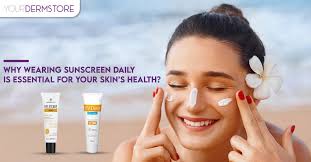
Sunscreen and its use
A common misconception about summer and sun protection is that you need to apply sunscreen only during summer and only when you are in direct sunlight.
In fact, even if you stay at home all year round, lack of sun protection can lead to most skin problems.
Harmful effects of UVA and UVB rays:
Harmful UVA and UVB rays can penetrate the outer layer of the skin and cause inflammation, sunburn and even cell damage.
Sunscreen forms a barrier between the skin and harmful environmental influences and acts as a filter to protect the skin from the harmful effects of the sun.
From premature skin aging to pigmentation, fine lines, collagen degradation and skin spots, UV rays usually cause the most severe skin damage.
UVA and UVB rays are the main cause of almost 80% of skin problems. UVB rays can only penetrate the first layer of the skin, the epidermis, while UVA rays can penetrate deep into the dermis.
UVB rays cause the skin to tan, while UVA rays can reach the second layer of the skin that houses living cells. 90% of the sun’s rays are UVA rays, which accelerate the aging process of the skin.
The dermis contains important elements like capillaries, melanin, nerve endings, collagen, elastin, etc. Therefore, it is very important to protect this layer of the skin.
Damage to this layer accelerates the signs of skin aging, slows down the healing and regeneration of skin cells, and makes the skin look dull and dehydrated.
Broad spectrum sunscreens protect against both types of UV rays. SPF 30+ protects your skin from 96% of UV rays and blocks them for 2 to 3 hours without sweating.
Titanium dioxide reflects and absorbs the sun’s rays, and is therefore an important part of any sunscreen.
Sunscreens:
There are different types of sunscreens that reflect UV rays, thus protecting your skin from carcinogenic effects.
To prevent premature aging, wrinkles, dark spots, fine lines, redness, rashes, pigmentation, and many other skin problems, it is important to know which sunscreen is right for your skin.
Once-a-day sunscreens:
These sunscreens are perfect when you are exposed to the harmful rays of the sun for long periods of time during your beach vacation.
These sunscreens are usually applied once a day and are usually waterproof.
Because these creams are only used once a day, they clog pores and form a thick protective layer on the skin. This can lead to acne, pimples, blackheads, and other skin problems.
Avoid using this type of sunscreen if you are not exposed to direct sunlight all day.
Waterproof sunscreens:
These sunscreens are specially designed to protect your skin even in the water.
It is especially important that they are not easily washed off, so you are fully protected from the sun even at the pool or beach.
These waterproof sunscreens do not provide all-day protection because you will towel dry your skin after leaving the water. After towel drying, the product may make your skin unprotected.
To avoid risks, reapply these products every time you leave the water and dry your body.
Anti-aging sunscreens:
While every sunscreen protects your skin from sun damage and slows the signs of aging, anti-aging sunscreens focus more on protecting your skin from premature aging.
These products contain additional anti-aging ingredients to keep your skin optimally moisturized and smooth, preventing wrinkles and fine lines.
Since these products have multiple benefits, such as slowing down skin aging while protecting your skin from harmful sun rays, their ingredients are often difficult to understand.
To ensure that you are not doing anything harmful to your skin, you should carefully check the complete ingredient list.
Gel sunscreens:
Gel sunscreens are best for oily skin. In humid air and hot weather, gel sunscreens cool and control sweat and sebum.
These products are lightweight, absorb quickly, and protect your skin at a cellular level.
These products will not make your skin look greasy. They fight sweat and acne. These sunscreens will not make your skin oily or look dull. For optimal coverage, reapply sunscreen every 3 hours.
Sunscreens:
Cream sunscreens are the most common and stable. They moisturize the skin. Although they are easily absorbed into the skin, it will make you feel like you are using a moisturizer.
These products are suitable for dry to sensitive skin.
Creamy, oily sunscreens can be annoying in humid summer weather. The oily nature of the product can lead to increased sweating. Heavy, creamy formulas can clog pores and trigger acne.
Therefore, choosing the right sunscreen texture can be a challenge.
However, sun protection is essential for long sunbathing days. Even if you stay indoors all day, you should not skip applying sunscreen in the morning.
Even if you are not directly exposed to the sun, harmful UV rays can affect your skin.
Ollie’s Damn Sun! with SPF 30++ Sun Protection
Damn Sun! is a weapon specially developed to fight the sun. It protects against harmful UVA and UVB rays that penetrate and damage skin tissue when exposed to sunlight.
Not only does it protect your skin from sunburn, it also reduces the appearance of sunburn, discoloration, and dark spots. It also prevents sagging, roughness, and wrinkles.
It acts as a blue light filter to block the glare from electronic devices and prevents skin damage caused by using digital screens.
This product also helps maintain the overall tone and health of the skin.
Key Ingredients
Damn, Sun! contains titanium dioxide, calendula, Himalayan cherry, aloe vera extract, and sesame oil.
Benefits
Titanium dioxide acts as a sunscreen to prevent sun damage.
Sesame oil acts as a blue light filter for the skin.
Himalayan cherry, which is rich in vitamin C, has skin-whitening properties.
Aloe Vera reduces tanning and prevents acne.
Calendula soothes and nourishes the skin.
A stable blend of sunscreen key ingredients gives your skin a new glow and healthy look. It prevents premature skin aging.
The lightweight formula absorbs quickly and regenerates cells.
Application
After cleansing, toning and applying makeup, gently apply the product to the face and neck. Massage gently outwards. Apply evenly to the skin before sun exposure.
For maximum protection, reapply every 2-3 hours. With regular use, your skin will improve noticeably.
AULI Ultra Nourish, All Day Moisturizing Body Lotion, SPF 30++
Hydrate your skin and protect it from burning damage with this body lotion. To prevent rough, chapped and dry skin, use Ultra Nourish immediately after showering, shaving and exfoliating.
This SPF 30++ body lotion is rich in minerals to lock in moisture and nourish the skin, helping to reduce moisture loss.
Ultra Nourish protects against sun damage, reduces tan lines, provides smooth skin texture and even skin tone.
Key Ingredients
Ultra Nourish consists of titanium dioxide, almond milk, coconut oil, calamine, aloe vera and herbal extracts.
Benefits
Titanium dioxide protects against sun damage.
Aloe vera retains moisture and prevents moisture loss from the skin surface.
Coconut oil reduces uneven skin tone and tan lines.
Almond milk brightens and moisturizes.
Calamine has a calming effect and prevents rashes.
Application
Apply evenly to body after showering daily and massage in gentle circular motions.
Brand History
Auli is committed to providing effective and affordable natural solutions to skin problems. The Auli team is passionate about revolutionizing skincare and simplifying technical terms.
Auli products are effective skincare solutions that effectively help achieve healthy and naturally glowing skin while treating specific skin problems.
Enriched with active ingredients, Auli has always focused on providing stable products and raising awareness for skincare.
Auli is a holistic lifestyle experience that blends the best of modern science and Ayurveda.


